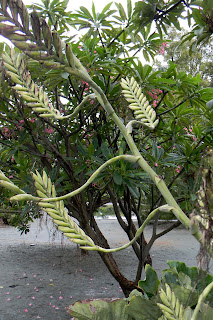So the last week was for seeing everyone's teaching presentation, but on Thursday Aug. 5 we had a free day. So, Pearl, Stephanie W. (our intrepid director), Debbie, Elise, Lynn, Stef and I went to the cochineal farm then to San Bartolo Coyotepec for some famous black pottery.
I have mentioned
cochineals here before, but it was cool to see how they are farmed for production.
Funny, on the website link I just posted here, you can buy 25 grams of the dead, dried cochineal bugs to make dye for the equivalent of $8.50 USD... I bought 25 grams of them at the farm for 75 pesos (= $5.88 USD, I should note at the time of these blog postings the exchange rate was $1 USD = $12.75 Mexican Pesos). Anyhoo...
S
howing us how they fill the little woven nests with eggs. The nests are hung on the nopal pads, and are left there until they hatch. (See below).
Once they hatch, the bugs infect the cactus. The dye produced by these little bugs (females only, the boy bugs "do the deed" and die usually within 7 days of hatching) has been such a hot commodity that the Mixtec people worked out these farming techniques approx. 950 - 1521 CE/AD.
Once they are firmly infested in the nopal pads, the pads are removed and placed in sand in neat rows where each bin is labeled and dated. Dating is important, since the bugs can't be harvested for dye until they are three months old. They are hand-picked or hand-brushed off... it is for this reason that the "spineless" nopal cactus was produced through careful cultivation over the years.
Close up of the females (the large-ish oval shapes with the lines, they remind me of fat pill bugs). They produce a protective cottony like substance (the white stuff). Drawing of them here.
Close up of the males (see the wings, antennae and "tails"?!... They are MUCH smaller than the females, and we were very lucky to get shots of them since they don't live very long).
The cochineal produces a gorgeous red color, but when mixed with various acids or bases can make other colors too (i.e. mix with lime juice and it turns orange, add baking soda and it turns purple). I bought some of the dead dried bugs to use in my classroom to teach my students about natural dyes.
In the beginning, it was produced almost exclusively in Oaxaca by indigenous producers, and cochineal became Mexico's second most valued export after silver. Soon after the Spanish conquest (~1500s), it began to be exported to Spain, and by the 17th C. was traded as far away as India. They tried to export the bugs for production in other countries (and other Spanish colonies), but soon realized that 1) the temperature/ humidity wasn't right and 2) the bugs only want the nopal cactus, so if the cactus didn't grow there, neither did the bugs (the only other place that was similar enough to produce the cactus and the bugs was the mountainous areas of Peru... though I just found in my research, that you can get it to grow
in Texas too). It was so highly prized that it's price was regularly quoted on the London and Amsterdam Commodities Exchanges. However, the production and demand of cochineal fell sharply with the introduction of synthetic red dyes in the mid-19th C. It came back into demand when those particular synthetic red dyes were found to be cancer-causing (red M&Ms anyone?). OK, enough history lesson!
More here if interested. Oh, and BTW, there's probably cochineal (labeled sometimes as cochineal extract, carmine or carminic extract) in some of your foods/drinks and lipstick...
Then we went and had lunch at a roadside restaurant where Stef had seen the roasting chickens, and it was a *great* choice, amazing roasted chicken with rice, pasta salad and warm tortillas. YUM! All with a drink for a whopping 35 pesos (= $2.75 USD). Gonna miss those prices!
Through a suggestion by fellow NEHer Nicole, we then went to Doña Sofia Reyes' black pottery workshop instead of one of the more touristy places (usually these workshops, whether for pottery, textiles or other arts, are the home of the producer with a workshop and/or small store area).
THE Doña Sofia Reyes. She's a very spry 91 years young, she says because of her "manos duros" (strong hands from making pottery for so many years and still to this day). BTW, Doña is a term of respect meaning Madame or Lady.
Once the pot has been made and dried a few days to "leather hard", it is then when Doña Sofia's daughter carves the cut-outs and impresses various textures. The clay starts out brown as you see here, it is a special local clay.
After the designs and cut-outs, Doña Sofia's granddaughter burnishes (rubs) the pots all over with a piece of quartz (or sometimes a smooth river stone) to give it shine. Only after all that, is the pottery fired in a big pit with all the other pieces that are ready (sometimes you have to wait weeks to have a firing so that you have enough pieces to fire). It is during the firing process where the pots turn black from lack of oxygen. The pots are then ready to sell!
Doña wasn't very good about taking pictures, but I wanted to give you a size comparison(I'm ~5' 8" and stooping alittle). So many lovely geriatric Oaxacan woman are little!



















































